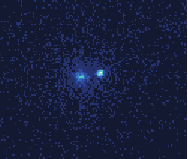Blade
The 'blade' trap is a macroscopic, 3-dimensional linear Paul trap consisting of four blade-shaped electrodes which provide the radial pseudopotential, and two needle-shaped electrodes to provide axial confinement. The trap itself measures approximately 30 x 24 mm and was designed and built in-house. It operates at room temperature in ultra-high vacuum.
Blade trap mounted inside its "spherical octagon" shaped vacuum system.

trapped in the same trap
Credit: Dr. Vera Schäfer
Mixed-species quantum logic
We co-trap ions of two different atomic elements: calcium and strontium. Working with different species has many advantages; since their atomic transition frequencies differ, the electronic quantum state of one species may be manipulated without corrupting that of the other. One species may be 'sympathetically' cooled using lasers which couple only to the other, and individual qubit addressing with low cross-talk can be achieved.
Different ions have properties which make them well suited for different computing tasks. For example, 43Ca+, with a nuclear spin of 7/2, features a 'clock' or 'memory' qubit whose frequency is first-order insensitive to fluctuations in the local magnetic field strength. This allows for an exceptionally long coherence time (T2* = 50 seconds without dynamical decoupling [Phys. Rev. Lett. 123, 110503, Phys. Rev. Lett. 113, 220501]), which is essential for processing and storing quantum information with low error rates. 88Sr+, on the other hand, is better suited for coupling to photons for communication across an optical quantum network [link to Optical Networking page]. The ability to transfer information between ions of different species provides the flexibility to use that which is best suited for each task. Recent work in this apparatus has achieved the highest entanglement fidelity between ions of two different atomic elements to date [Phys. Rev. Lett. 125, 080504], using a single laser to couple simultaneously to both species. We have since demonstrated alternative methods of generating mixed-species entanglement with similarly high fidelity, and are working on some of its many applications.
Fast gates
All operations necessary for quantum computing (including initial qubit-state preparation, single- and two-qubit gates, and readout) have been demonstrated with trapped ions. Two-qubit gates have typically been the slowest of these operations by around an order of magnitude, with entangling gate speeds usually limited by the motional period of the ions in the trap. Recent work in the Blade trap demonstrated the first trapped-ion two-qubit gate to exceed this speed limit, and we achieved a 99.8% fidelity gate in only 1.6μs [Nature 555, 75–78]. The apparatus is currently being used to extend this work, using additional stabilisation of the optical phase of the gate laser beams: see Fast Gates for more details.
People
Current
- Dr. Chris Ballance (PI)
- Prof. David Lucas (PI)
- Amy Hughes (Postdoc)
- Dr. Mariella Minder (Postdoc)
- Oana Bazavan (Graduate student)
- Sebastian Saner (Graduate student)
Former
- Dr. Vera Schäfer (Graduate student)
- Dr. Keshav Thirumalai (Graduate student)
- Sarah Woodrow (Masters student)
Contact
Publication highlights
- Benchmarking a High-Fidelity Mixed-Species Entangling Gate, Phys. Rev. Lett. 125, 080504 (2020)
- Fast quantum logic gates with trapped-ion qubits, Nature 555, 75–78 (2018)
- Hybrid quantum logic and a test of Bell's inequality using two different atomic isotopes, Nature 528, 384–386 (2015)
